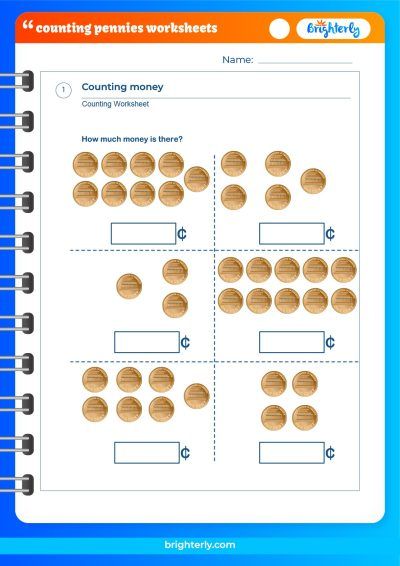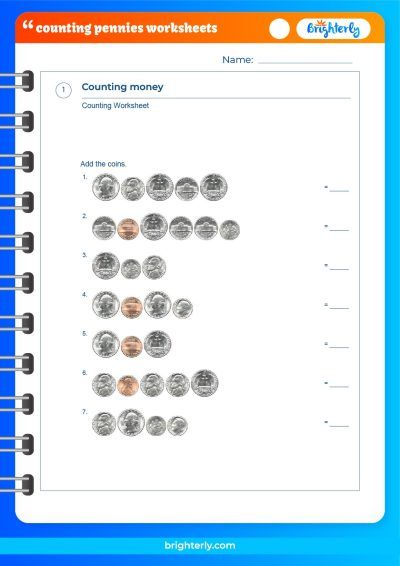Pennies in Math – Definition With Examples
Updated on January 7, 2024
Welcome to another exciting exploration of the enchanting world of mathematics with Brighterly. Today, we will delve into a seemingly simple but significantly powerful concept: Pennies in Math. You may wonder, ‘how can a common penny help my child in understanding math?’ Well, you’re about to find out.
In the world of learning, we believe in the power of tangible teaching tools and real-life applications, and the simple penny is one such example. More than just a coin, a penny represents a practical, engaging, and comprehensible unit of measurement that can bring to life the seemingly abstract world of numbers for young learners.
What Are Pennies in Math?
In the world of mathematics, a penny, much like the one you may find lying around in your piggy bank, represents more than just a unit of currency. From a mathematical perspective, pennies are used as a practical, relatable, and tangible unit of measurement. They are an excellent tool for teaching basic mathematical concepts and operations like addition, subtraction, multiplication, and division. By considering real-world items like pennies, children can create a concrete understanding of otherwise abstract concepts.
When dealing with pennies in math, we’re not only referring to physical coins but symbolic representations as well. They could be actual pennies, images of pennies, or even the number 1 used to symbolize a penny. This concept makes math more interactive, interesting, and easy to grasp, especially for young learners.
Definition of Pennies in Math Context
In a mathematical context, pennies are defined as discrete units that can be counted, added, subtracted, multiplied, and divided. They act as a simple way to understand numbers and their relationships, as they provide a visual and physical aid to learning.
A penny, therefore, is the fundamental unit that represents the number one in calculations. This usage helps in making mathematical operations more relatable as students can visualize and manipulate pennies during problem-solving, reinforcing the mathematical principles at play.
Role of Pennies in Math
Pennies play an integral role in teaching mathematical operations. They can be utilized to understand the idea of counting, which forms the foundation of mathematics. Besides, pennies are useful in illustrating and practicing addition, subtraction, multiplication, and division concepts.
In addition to these basic operations, pennies also play a role in teaching more complex mathematical concepts such as decimal operations, fractions, and percentages. They serve as a bridge between theoretical concepts and real-world applications, thereby fostering a comprehensive understanding of mathematical principles.
At Brighterly, we believe that practice is the key to mastery. That’s why we invite you to explore our pennies worksheets, where you can find an array of additional practice questions, complete with answers.
Properties of Pennies in Mathematical Calculations
In the realm of mathematical calculations, pennies have certain properties that make them extremely useful as teaching tools. Each penny is identical, meaning they have the same shape, size, and value. This uniformity makes them ideal for representing numbers and performing calculations.
Since each penny represents a single unit, they embody the principle of unitization, crucial in understanding and executing more complex mathematical operations. Also, their discrete nature makes them perfect for dealing with whole numbers, and the coin’s monetary value can be used to introduce fractions and decimals in a practical and relatable way.
Use of Pennies in Addition and Subtraction
Pennies serve as a perfect tool for teaching addition and subtraction to young learners. For example, if a child has three pennies and you give them two more, they physically add the pennies together to get five. Similarly, if they have five pennies and spend two, they physically remove two pennies and see that three remain.
This physical act of adding and taking away helps children understand the principles of addition and subtraction in a more concrete way, which aids in strengthening their mathematical foundation.
Use of Pennies in Multiplication and Division
When it comes to multiplication and division, pennies can again be utilized as practical learning tools. Multiplication can be thought of as multiple additions, so if we have three groups of four pennies, we can count the total to understand that three multiplied by four equals twelve.
In the same vein, division can be taught as the partitioning of a group of pennies into equal smaller groups. For instance, if you have twelve pennies and you divide them into four equal groups, each group would contain three pennies, thereby visually demonstrating that twelve divided by four equals three.
Difference Between Using Pennies and Other Units in Math
Using pennies as units in math has its unique benefits compared to other units like abstract numbers or more complex items. As they are physical and uniform units, pennies can make abstract mathematical concepts more concrete and digestible.
However, it’s important to note that pennies are mostly suitable for introducing basic mathematical concepts. When it comes to more advanced mathematical concepts, other units like numbers, variables, and functions become necessary.
Equations Involving Pennies
Equations involving pennies use the same principles as other mathematical equations. Here, the penny stands in for a unit, often represented as the number one, but the steps to solving the equation remain the same. For example, in an equation like 1p + 2p = 3p, ‘p’ stands for pennies.
Writing Equations Involving Pennies in Addition and Subtraction
When creating equations involving pennies for addition or subtraction, we follow the same principles as with regular numbers. For instance, if a child has two pennies and their friend gives them three more, we can represent this situation with the equation 2p + 3p = 5p.
In subtraction, if a child has five pennies and spends three, we can write the equation as 5p – 3p = 2p.
Writing Equations Involving Pennies in Multiplication and Division
Multiplication and division equations involving pennies follow the same pattern as regular multiplication and division equations. For example, if a child has three groups of four pennies, this situation can be represented by the equation 3 * 4p = 12p.
Similarly, for division, if twelve pennies are divided into four groups, we can represent this as 12p ÷ 4 = 3p.
Practice Problems on Pennies in Math
Now that we’ve learned about pennies and how they can be used in math, let’s test your knowledge with some practice problems. Can you solve these?
- You have 5 pennies, and you get 4 more from a friend. How many pennies do you have now?
- You have 10 pennies but spent 3 on a small toy. How many pennies are left with you?
- You have 3 groups of 5 pennies each. How many pennies do you have in total?
- You have 12 pennies. If you divide them equally into 4 groups, how many pennies are there in each group?
Conclusion
In conclusion, at Brighterly, we believe in turning every learning opportunity into an exciting and interactive journey for our young learners. With pennies, a ubiquitous and simple element of everyday life, we can unveil the fundamental concepts of mathematics in a fun and practical manner.
This unique approach aids not only in the conceptual understanding of mathematics but also contributes to the development of skills such as problem-solving, logical reasoning, and even financial literacy. By embedding math in their world, we ensure the concepts stick with them beyond the classroom, well into their life. So, dive into the world of pennies with us and watch as math transforms from an abstract subject into a relatable, hands-on experience.
Frequently Asked Questions on Pennies in Math
What does a penny represent in math?
In math, a penny is far more than a simple coin; it stands as a single, tangible unit that can be used to perform basic arithmetic operations. When we use pennies in math, we’re essentially representing numbers and calculations in a physical form. This approach makes learning a more interactive experience and allows young learners to grasp abstract mathematical principles in a more concrete, tangible way.
How can pennies help in learning math?
Pennies, being physical and uniform, provide a direct, hands-on method for learning math. This concrete approach aids in developing a strong foundational understanding of math concepts and processes. For instance, young learners can use pennies to physically add or subtract, providing a visual demonstration of these operations. It’s also a practical way to introduce concepts like multiplication (repeated addition) and division (equal distribution), as well as more advanced ideas like fractions, percentages, and decimal operations.
Can pennies be used for advanced mathematical operations?
While pennies are primarily used to explain and practice basic operations, their use extends into more advanced mathematical areas as well. For example, when we introduce concepts like decimals and fractions, we can use the monetary value of a penny (0.01 or 1/100) to represent these ideas in a way that is intuitive and relatable. So, pennies can indeed serve as a bridge to more advanced mathematical concepts, grounding them in real-world, practical examples.
Information Sources:
For additional information, you can visit the following sources:






